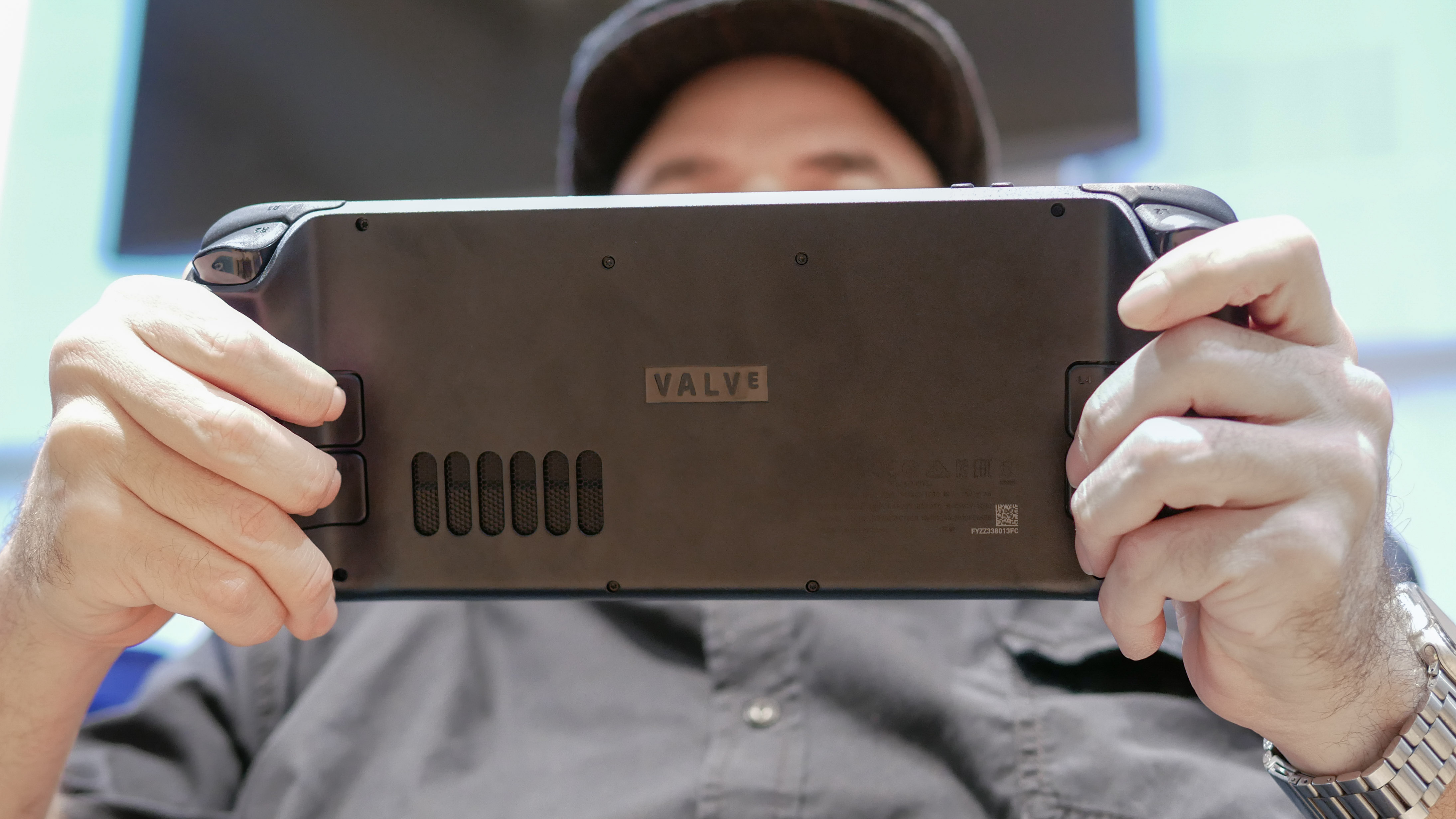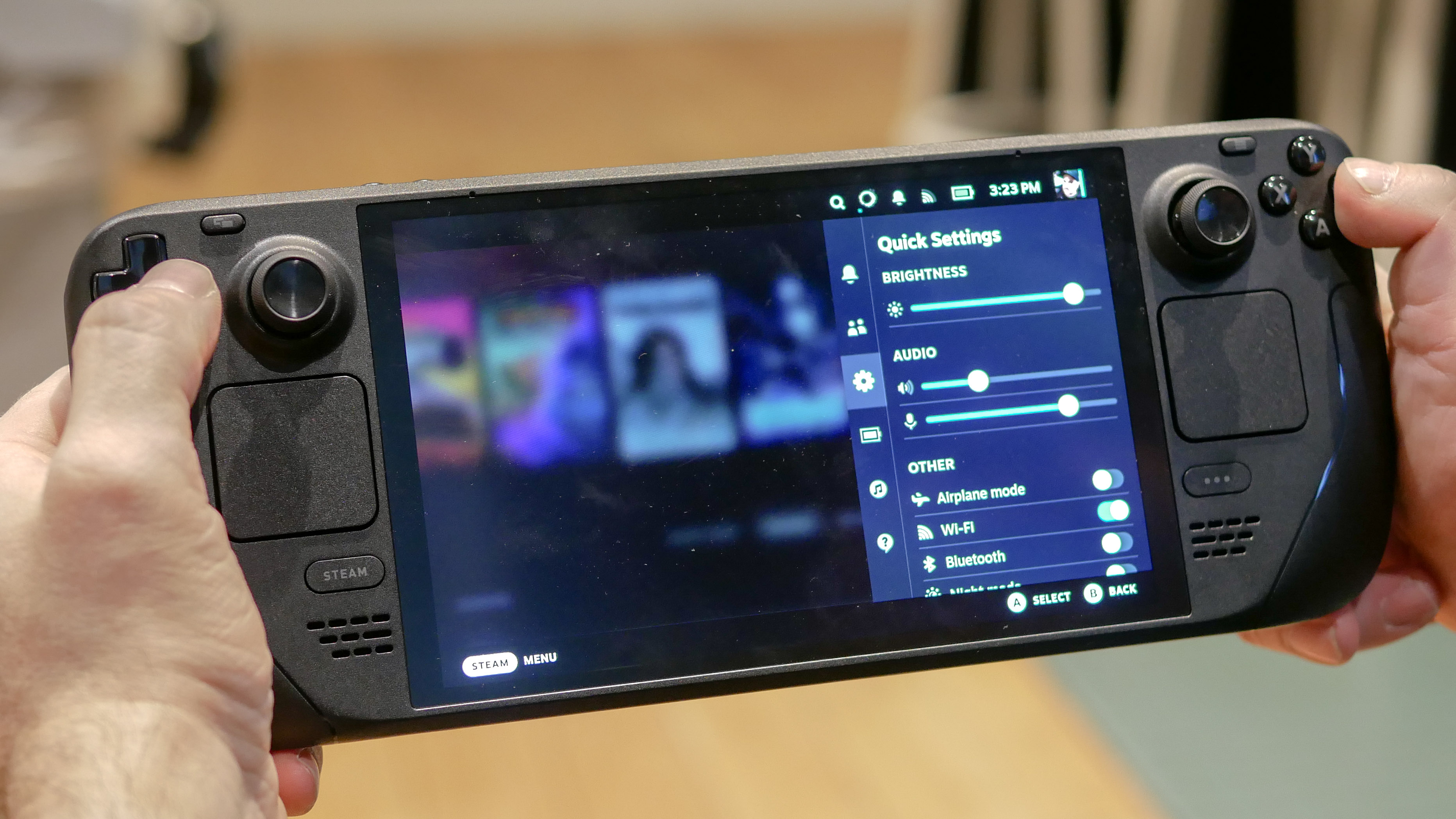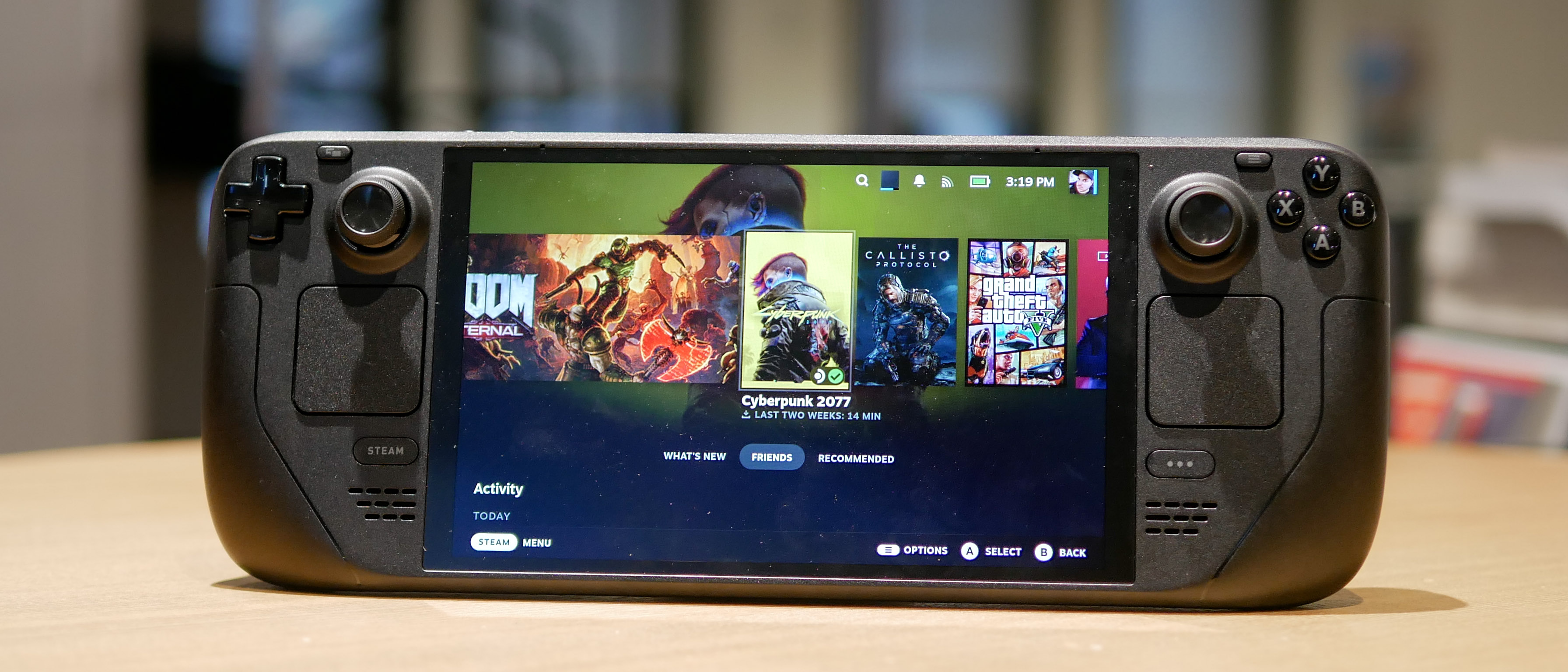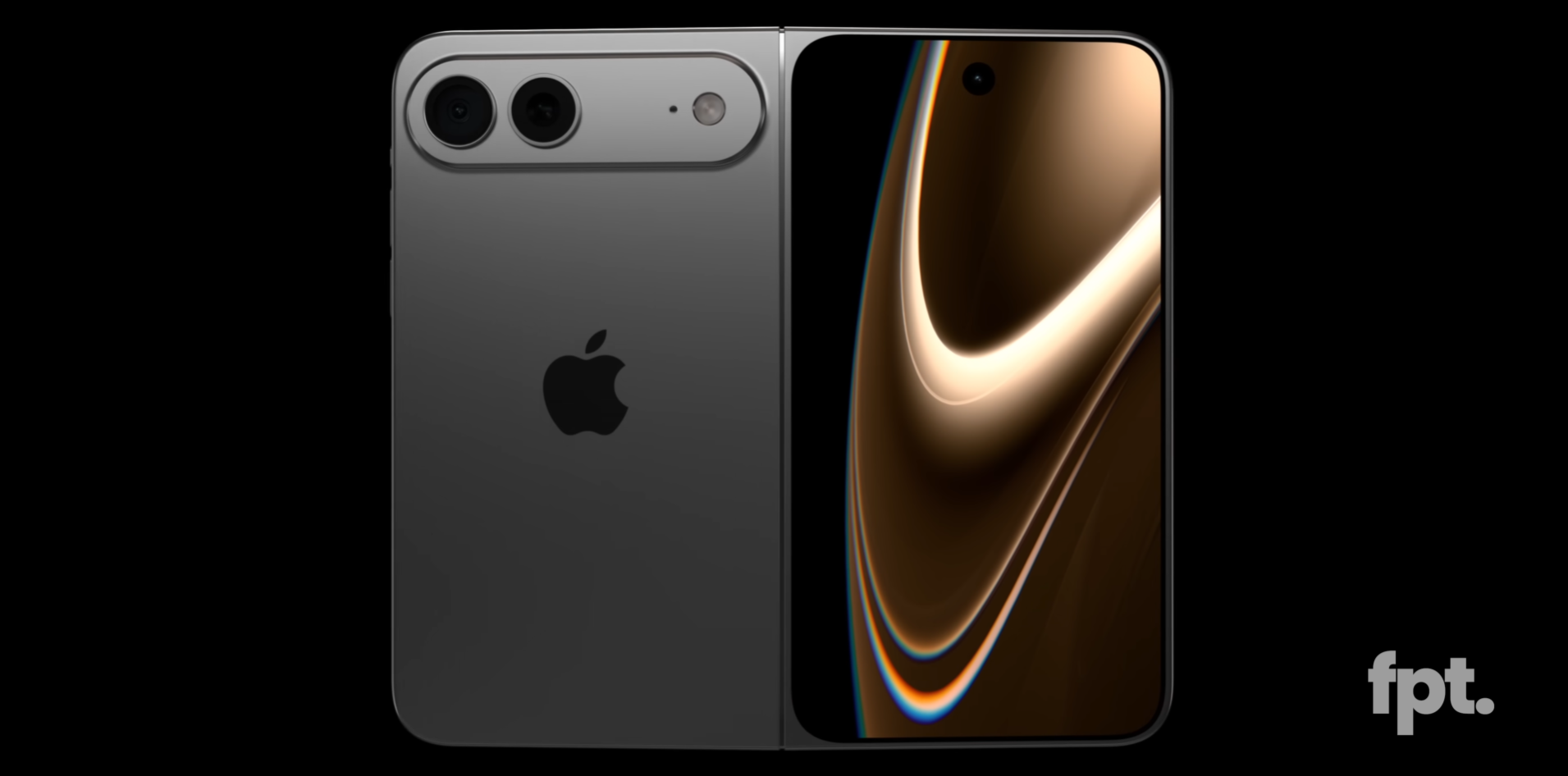Tom's Guide Verdict
The Steam Deck OLED impresses thanks to its vibrant display, lighter design, faster Wi-Fi and improved cooling. The original model was great, but this latest iteration demonstrates that Valve can improve on perfection. The Steam Deck OLED has set a new standard for competitors to follow.
Pros
- +
Bright and color OLED display
- +
Lighter build
- +
Faster Wi-Fi
Cons
- -
Display is only major improvement
Why you can trust Tom's Guide
The Steam Deck OLED is the real deal. While it’s not a revolutionary upgrade over the original Steam Deck, new features like an OLED HDR-capable display, Wi-Fi 6, and improved cooling make a huge difference. Like its predecessor, this handheld is an engineering marvel.
I’m a big fan of the Steam Deck and prefer it to more powerful Windows 11 handhelds like the Asus ROG Ally and Lenovo Legion Go. The Steam Deck OLED is an even better version of the original device. If you already own a Steam Deck and only play it occasionally, you probably don’t need to upgrade. However, purchasing it is a no-brainer if you’re new to Steam Deck or if the original is your primary gaming platform.
In my full Steam Deck OLED review, I’ll go over the handheld’s strengths and weaknesses to help you decide if you should buy or skip it.
Steam Deck OLED review: Specs
| Row 0 - Cell 0 | Steam Deck OLED (512GB) | Steam Deck OLED (1TB) |
| Price | $549 | $649 |
| Chipset | Custom AMD Zen 2 "Van Gogh" APU | Custom AMD Zen 2 "Van Gogh" APU |
| Storage | 512GB | 1TB |
| Operating system | SteamOS | SteamOS |
| Display | 1280 x 800 HDR OLED | 1280 x 800 HDR OLED (anti-glare etched glass) |
| Ports | 1 USB-C, 1 3.5 mm audio jack, 1 microSD card reader | 1 USB-C, 1 3.5 mm audio jack, 1 microSD card reader |
| Dimensions | 11.73 x 4.6 x 1.93 inches | 11.73 x 4.6 x 1.93 inches |
| Weight | 1.4 pounds | 1.4 pounds |
| Battery | 3 to 12 hours (rated) | 3 to 12 hours (rated) |
Steam Deck OLED review: Price and availability
The Steam Deck OLED is available now on the Steam store.
There are two different OLED versions to choose from. The $549 model has 512GB of SSD storage while the premium $649 edition packs a big 1TB SSD and an anti-reflective display. Both units come with a carrying case.

Valve is phasing out the old 64GB and 512GB models and is now selling them at a reduced price of $349 and $449, respectively. These will be available until stock runs out. The original 256GB Steam Deck (which is the one I own) now serves as the entry-level Steam Deck model at $399.
Steam Deck OLED review: Design
At a glance, the Steam Deck OLED is indistinguishable from the original model. It retains the same controller layout, ergonomic handgrips and port placement. The all-black plastic chassis looks and feels as great as ever.
Get instant access to breaking news, the hottest reviews, great deals and helpful tips.
The new Steam Deck is as large as the original at 11.7 x 4.6 x 1.9 inches. However, it’s now lighter at 1.4 pounds. 1.5 to 1.4 pounds might not seem like a massive difference, but trust me, it makes the system easier to hold for longer periods. I originally said the Steam Deck was the biggest gaming handheld I’d ever tested. But after going hands-on with the giant Lenovo Legion Go, Valve’s machine seems tiny in comparison.

There are two analog sticks and two trackpads on either side of the display, along with a D-pad on the left and X/Y/A/B buttons on the right. The View and Menu buttons serve as Select and Pause in-game, respectively, while the Steam and Quick Access buttons let you access SteamOS.
Volume buttons, a 3.5 mm headphone jack, a USB-C port and a power button reside between the shoulder buttons. There are also four programmable back buttons and an SD card reader on the Steam Deck’s underside. Two speakers reside underneath the Steam and Quick Access buttons, respectively. You’ll also find air vents along the top.
Overall, I’m happy Valve didn’t radically alter the Steam Deck’s design since it already looked great. Also, since the new Steam Deck is the same size as the original, it will fit inside any cases or skins you may have purchased for it.
Steam Deck OLED review: Display

The Steam Deck’s OLED display is a wonder to behold. It’s brighter than ever, and the contrast between dark and light elements makes the vibrant colors really pop. Thanks to the thinner bezels, the display size is now 7.4 inches wide compared to 7 inches — giving you more to see.
As I did on the original Steam Deck, I tested Cyberpunk 2077, Doom Eternal and Marvel's Spider-Man. These titles look impressive on the original Steam Deck’s LCD display, but are jaw-dropping on the OLED model thanks to the vibrant image quality. In particular, I was most impressed when I enabled HDR in each game. I was more than happy to have my retinas scorched by the bright neon lights in Cyberpunk 2077, for example.
Our lab tests confirmed my anecdotal experience. When we pointed our Klein K10-A colorimeter at the screen, we found that it achieved 597 nits of brightness. That’s not only brighter than the Lenovo Legion Go (476 nits) and Asus ROG Ally (465) but much brighter than the original Steam Deck, which averaged 169 nits of brightness.
When we tested the Steam Deck's HDR luminance, we found that it achieved 969 nits of brightness when viewing HDR content. That's not the advertised 1,000 nits, but I doubt anyone will complain.
| Header Cell - Column 0 | Steam Deck OLED | Steam Deck | Asus ROG Ally | Lenovo Legion Go |
|---|---|---|---|---|
| Nits (brightness) | 597 | 169 | 465 | 476 |
| sRGB | 143.7% | 68.5% | 108.6% | 151.8% |
| DCI-P3 | 101.8% | 48.5% | 76.9% | 107.5% |
| Delta-E | 0.22 | 0.25 | 0.17 | 0.21 |
Regarding color saturation, the Steam Deck OLED achieved 143.7% of the sRGB color gamut and 101.8% of the more demanding DCI-P3 color space (closer to 100% is best for both). Color accuracy-wise, the screen scored 0.22 on the Delta-E test (closer to 0 is best).
In contrast, the Legion Go (151.8% / 107.5% / 0.21) delivers more oversaturated colors while the Asus ROG Ally (108.6% / 76.9% / 0.17) produced less saturated hues. All of these handhelds’ respective screens make the screen on the original Steam Deck (68.5% / 48.5% / 0.25) appear dull in comparison.
Overall, I'm very happy with the new OLED display. That, along with the anti-glare feature of our review unit makes a huge visual difference. It's one of those things you need to see for yourself to truly appreciate.
Steam Deck OLED review: Controls

As I mentioned above, the new Steam Deck has the same controller layout as before — which is itself the same layout you’ll find in most modern controllers. The buttons are bigger than those found on the Nintendo Switch’s Joy-Con controllers but smaller than the buttons on an Xbox Series X or PS5 DualSense controller.
That said, the thumbsticks are more concave than the previous model, making them more comfortable to use. The sticks (and buttons) provide a satisfying level of resistance. Like before, the back buttons are located where your middle and ring fingers naturally rest, which makes them easy to reach.

The games I mentioned above felt as intuitive to play on Steam Deck as on console and PC. Whether it was mowing down and evading monsters in Doom Eternal, driving through Night City in Cyberpunk 2077, or web-zipping across Manhattan in Spider-Man, the controls are perfect for most games. That said, I still find using the trackpads underneath the analog sticks cumbersome for RTS games like Command & Conquer: Remastered.
Since I liked the controls of the original Steam Deck, I have nothing to complain about with the new handheld’s controls. Everything just feels awesome to play.
Steam Deck OLED review: Performance

The Steam Deck OLED packs an updated Zen 2 AMD chip (6nm compared to 7nm). Despite that, the new handheld has roughly the same performance as the older model. That could be good or bad, depending on whether you expected better performance or not. I don’t have a problem with this since Steam Deck’s gaming performance is overall solid for its specs.
At their respective medium graphical settings, Doom Eternal and Spider-Man ran between 35 to 45 frames per second during my testing. Since the latter is a giant open-world game, these results are very impressive. Speaking of open-world games, Cyberpunk 2077, which has a dedicated “Steam Deck” graphical setting ran at a consistent 30 fps. These are the same values I experienced on the original Steam Deck, so I’m not complaining about performance.
| Header Cell - Column 0 | Lenovo Legion Go | Asus ROG Ally | Steam Deck OLED |
|---|---|---|---|
| Cyberpunk 2077 | 23 fps | 24 fps | 29 fps |
| Dirt 5 | 41 fps | 45 fps | 41 fps |
| Shadow of the Tomb Raider | 23 fps | 26 fps | 44 fps |
The Steam Deck OLED holds its own against handhelds featuring better hardware, as you can see from the table above. Keep in mind that we benchmarked the Asus ROG Ally and Lenovo Legion Go at 1080p and the Steam Deck OLED at 720p since that’s the latter’s max resolution.
Steam Deck OLED review: Battery life & heat
Since Valve hasn’t released a necessary Windows 11 driver update, we were unable to perform our in-house battery test on the Steam Deck OLED. Because of that, I’ll focus on my anecdotal experience.
Valve claims the Steam Deck OLED has 30-50% more battery life thanks to its larger battery and how the OLED display draws less power. The updated AMD APU is another factor that’s supposed to prolong battery life, according to Valve.
Based on my testing, the Steam Deck OLED lasts longer than its predecessor. For instance, I was able to play Spider-Man at medium settings for a little over two hours on the updated device. On the previous version, I was lucky to wring 90 minutes of playtime. On less demanding games like TMNT: Shredder’s Revenge, battery life can last for several more hours. Valve wasn’t kidding about improved battery life.
Heat-wise, the system’s vents don’t get nearly as hot as on the original model. The air flowing out of the top vents is certainly warm, but not dramatically so. Granted, you won’t feel much heat since the vents aren’t near your hands, but it’s good to know you won’t scorch yourself if you touch the vents.
Steam Deck OLED review: Outlook
The Steam Deck OLED improves upon an already great handheld and is now the definitive version to buy for newcomers or hardcore Steam Deck users. The gorgeous OLED panel alone is worth the price of admission, but other updates such as faster Wi-Fi, a lighter build and better cooling make the system more enticing. The Steam Deck OLED sets a new standard for other handhelds to emulate.

Tony is a computing writer at Tom’s Guide covering laptops, tablets, Windows, and iOS. During his off-hours, Tony enjoys reading comic books, playing video games, reading speculative fiction novels, and spending too much time on X/Twitter. His non-nerdy pursuits involve attending Hard Rock/Heavy Metal concerts and going to NYC bars with friends and colleagues. His work has appeared in publications such as Laptop Mag, PC Mag, and various independent gaming sites.











